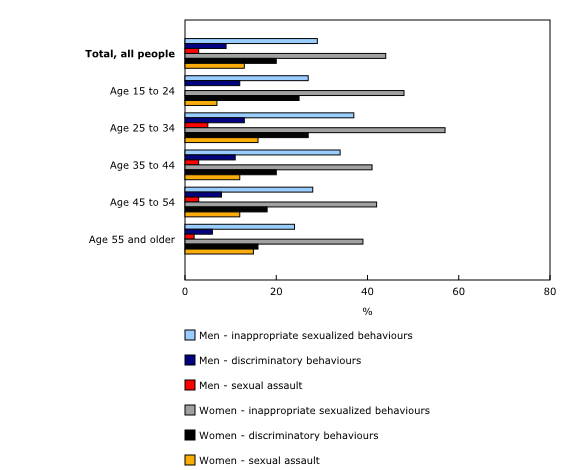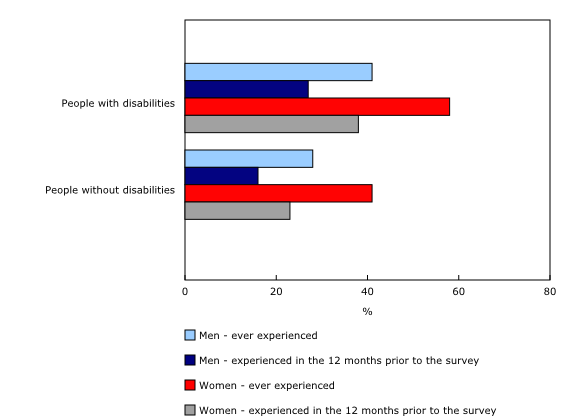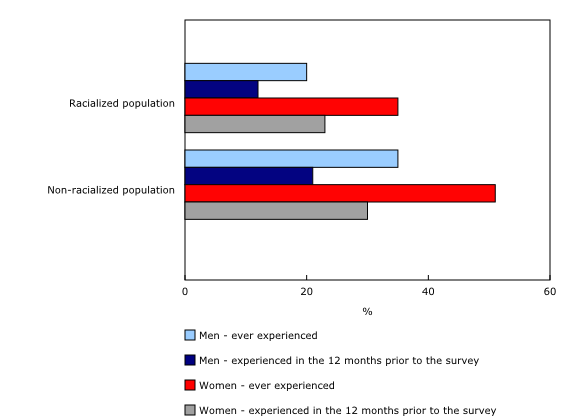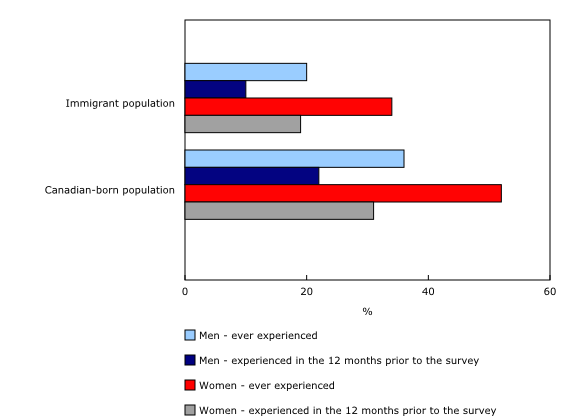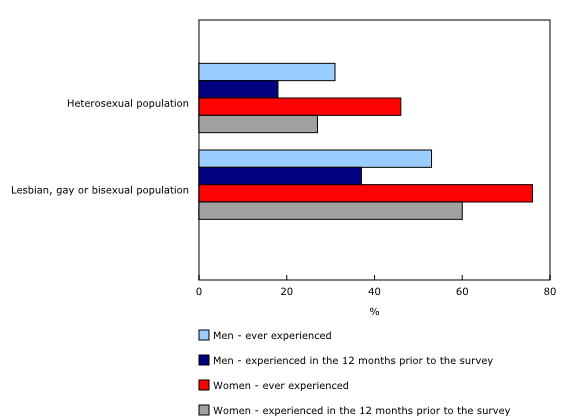Gender Results Framework: A new data table on workplace harassment
Released: 2024-02-12
Statistics Canada's Centre for Gender, Diversity and Inclusion Statistics, in collaboration with the Canadian Centre for Justice and Community Safety Statistics, has released a new data table on experiences of harassment and sexual assault in the workplace. This data table reports on the Gender Results Framework (GRF), introduced by the Government of Canada in 2018 to track the progress of gender equality in Canada. The new data table also includes data collected through the 2020 Survey on Sexual Misconduct at Work (SSMW).
The first release of the 2020 SSMW was an infographic (Sexual misconduct and gender-based discrimination at work, 2020) and a Juristat article (Workers' experiences of inappropriate sexualized behaviours, sexual assault and gender-based discrimination in the Canadian provinces, 2020) published in August 2021.
Workplace harassment refers to objectionable or unwelcome conduct, comments or actions by an individual at any event or location related to work, which can reasonably be expected to offend, intimidate, humiliate or degrade the person experiencing them. It also includes inappropriate sexualized behaviour, discriminatory behaviour and sexual assault.
Inappropriate sexualized behaviour includes inappropriate verbal and non-verbal communication, behaviour related to sexually explicit materials, and unwanted physical contact or suggested sexual relations. Discriminatory behaviour includes discrimination based on a person's gender identity or gender expression and actual or perceived sexual orientation, or because a person is, or is believed to be, transgender.
Sexual assault includes sexual attacks; unwanted sexual touching; and sexual activity to which the victim was unable to consent because they were manipulated, coerced, intoxicated or forced in another non-physical way.
All results referring to experiences of harassment or sexual assault in the workplace or in a work-related setting occurred while the respondent was employed.
Nearly 1 in 2 women and roughly 3 in 10 men report ever experiencing harassment or sexual assault in the workplace
In Canada, 31% of men and 47% of women reported ever experiencing some form of harassment or sexual assault in the workplace.
The largest proportion of women reported ever experiencing inappropriate sexualized behaviours in a workplace setting (44%), followed by discriminatory behaviours (20%) and sexual assault (13%). A considerable proportion of men also reported ever experiencing inappropriate sexualized behaviours (29%), as well as discriminatory behaviours (9%) and sexual assault (3%) in the workplace.
Among employed people, those aged 25 to 34 years report the highest rate of ever experiencing harassment or sexual assault in the workplace
Among employed people, 60% of women and 39% of men aged 25 to 34 years reported ever experiencing harassment or sexual assault in the workplace. This was primarily driven by the rates of inappropriate sexualized behaviours reported by women (57%) and men (37%) aged 25 to 34.
When focusing on experiences of workplace harassment or sexual assault in the 12 months before the data were collected (experiences that occurred in 2019), the proportions for women (39%) and men (23%) aged 25 to 34 years remained relatively high. However, it was the 15- to 24-year-olds who reported the highest proportions of workplace harassment or sexual assault in the 12 months prior to the survey. More than 4 in 10 women (43%) and 1 in 4 men (25%) aged 15 to 24 reported experiencing harassment or sexual assault in the workplace in the 12 months prior to the survey.
New data table also provides information on harassment and sexual assault experiences among people with disabilities, Indigenous people, racialized people and immigrants
Among those with disabilities, 58% of women and 41% of men reported ever experiencing harassment or sexual assault in the workplace. Meanwhile, 41% of women and 28% of men without disabilities reported ever experiencing harassment or sexual assault in the workplace. People with disabilities may face additional challenges in the workplace, including limitations in participation in the workplace, and higher rates of harassment or sexual assault within and outside the workplace.
Among Indigenous people, rates of those who ever experienced harassment or sexual assault in the workplace were 43% among women and 30% among men, whereas 48% of non-Indigenous women and 31% of non-Indigenous men reported ever experiencing harassment or sexual assault in the workplace. The non-Indigenous group is composed of people identifying as racialized or non-racialized. The SSMW surveyed a relatively small number of Indigenous people; therefore, caution is necessary when interpreting the differences between Indigenous and non-Indigenous people.
Among racialized women, 35% reported ever experiencing harassment or sexual assault in the workplace, whereas 20% of racialized men reported ever experiencing harassment or sexual assault in the workplace. Among non-racialized people, 51% of women and 35% of men reported ever experiencing harassment or sexual assault in the workplace. The non-racialized group is composed of people identifying as Indigenous or White. Because of the categorization of non-racialized people, differences in harassment or sexual assault experiences between racialized people and Indigenous or White people individually cannot be reported in this release.
Just over one in three immigrant women (34%) and one in five immigrant men (20%) reported ever experiencing harassment or sexual assault in the workplace. Meanwhile, 52% of Canadian-born women and 36% of Canadian-born men reported ever experiencing harassment or sexual assault in the workplace. It is possible that figures for immigrants and racialized people are underestimated because of language barriers; the survey was conducted in English or French only.
These results show that people with disabilities and women overall were overrepresented among those who experienced harassment or sexual assault in the workplace. People with disabilities, women and Indigenous people are consistently overrepresented among people who experience harassment, discrimination and violence in many different areas of life. These results focus only on what takes place in the workplace.
Three in four lesbian, gay or bisexual women and more than one in two men in this group report ever experiencing harassment or sexual assault in the workplace
In 2020, 76% of lesbian, gay or bisexual (LGB) women and 53% of LGB men reported ever experiencing harassment or sexual assault in the workplace. Meanwhile, lower proportions of heterosexual women (46%) and heterosexual men (31%) reported ever experiencing harassment or sexual assault in the workplace.
When asked about the 12 months prior to the survey (experiences that occurred in 2019), 60% of LGB women and 37% of LGB men reported experiencing harassment or sexual assault in the workplace, whereas 27% of heterosexual women and 18% of heterosexual men reported the same.
Women are more likely to experience harassment and sexual assault inside and outside the workplace
The GRF is used to track the progress of gender equality in Canada over time. The data presented in this release support the goal of eliminating harassment and violence in the workplace by reflecting experiences of violence reported by people in Canada. These insights on harassment and violence in the workplace will continue to be tracked over time using a Gender-based Analysis Plus perspective, alongside other GRF indicators related to gender-based violence outside the workplace. The GRF indicators provide insights on the gender-based violence experiences of people in Canada, among other societal issues related to gender equality.
Research continues to highlight gender differences in workplace harassment and discrimination across all Canadian workplaces and in any type of occupation and setting. According to a Statistics Canada study, women were more likely than men to experience verbal abuse in the workplace, which was the most common type of workplace harassment. The same study found that women in health occupations experienced workplace harassment more than women in other fields, such as management occupations; business, finance and administrative occupations; natural and applied sciences and related occupations; sales and service occupations; and occupations in education, law and social, community and government services. It was also found that among women in all professions, over half reported clients or customers as perpetrators of sexual harassment.
A similar situation was found in the Canadian Armed Forces Regular Force, where experiences of sexual assault, sexualized behaviours and discriminatory behaviours were higher among women than men.
Women who worked in occupations that were historically dominated by men, such as trades, transport and equipment operators and related occupations, were also more likely to experience inappropriate sexualized behaviours.
In another study by Statistics Canada, women were more likely to experience workplace harassment and discrimination in postsecondary institutions. The infographic "Sexual misconduct and gender-based discrimination at work, 2020", released in 2021, indicated that 25% of women and 17% of men experienced sexual misconduct in their workplace in the previous year. Statistics Canada also reported that women were twice as likely as men to experience unwanted sexual behaviours in the workplace. In terms of sexually and gender diverse people, 2SLGBTQ+ workers were two to four times more likely to be targets of harassment or sexual assault in the workplace than their cisgender and heterosexual counterparts.
Women were also more likely than men to experience harassment and sexual assault outside the workplace. For example, Statistics Canada reported that women were three times more likely to experience unwanted sexual behaviours in public, four times more likely to have been sexually assaulted since age 15 and twice as likely to experience negative emotional consequences as a result of experiencing unwanted sexual behaviours, compared with men. As well, women were significantly more likely than men to report experiencing all forms of intimate partner violence (emotional, physical and/or sexual abuse).
Did you know we have a mobile app?
Get timely access to data right at your fingertips by downloading the StatsCAN app, available for free on the App Store and on Google Play.
Note to readers
The Gender Results Framework (GRF) data tables can be used to track the distribution and representation of women and men across a variety of topics and over time. For more information on the GRF and products disaggregated by gender, please visit the Sex, Gender and Sexual Orientation Statistics Hub.
The Gender, Diversity and Inclusion Statistics Hub supports Statistics Canada's Disaggregated Data Action Plan by connecting users to portals that feature disaggregated data on various population groups.
Whereas the Government of Canada adopted and encourages the use of the acronym 2SLGBTQI+ to refer to Two-Spirit, lesbian, gay, bisexual, transgender, queer and intersex people and those who use other terms related to gender or sexual diversity, for the purposes of data analysis, the acronym 2SLGBTQ+ is used in this document, as information is not yet specifically collected about intersex people in Statistics Canada surveys.
The 2020 Survey on Sexual Misconduct at Work collected information from people 15 years of age and older who have been in the workforce in the 10 provinces. For information on the methodology of the survey, see Survey on Sexual Misconduct at Work.
Comparisons across groups have not been tested for statistical significance, and thus data should not be compared. Some estimates in this article should be used with caution. For more information on the statistical differences across groups, please refer to the Juristat article "Workers' experiences of inappropriate sexualized behaviours, sexual assault and gender-based discrimination in the Canadian provinces, 2020."
Given that the non-binary population is small, data aggregation to a two-category gender variable is sometimes necessary to protect the confidentiality of responses. In these cases, individuals in the category "non-binary people" are distributed into the other two gender categories. Unless otherwise indicated in the text, the category "men" includes men, as well as some non-binary people, while the category "women" includes women, as well as some non-binary people.
References
Harassment in Canadian workplaces, Insights on Canadian Society (75-006-X).
Gender-based violence and unwanted sexual behaviour in Canada, 2018: Initial findings from the Survey of Safety in Public and Private Spaces, Juristat (85-002-X).
Intimate partner violence in Canada, 2018: An overview, Juristat (85-002-X).
Harassment and discrimination among faculty and researchers in Canada's postsecondary institutions, Insights on Canadian Society (75-006-X).
Workers' experiences of inappropriate sexualized behaviours, sexual assault and gender-based discrimination in the Canadian provinces, 2020, Juristat. (85-002-X).
Sexual misconduct and gender-based discrimination at work, 2020, Infographics (11-627-M).
Sexual misconduct in the Canadian Armed Forces, 2022 (85-603-X).
Contact information
For more information, or to enquire about the concepts, methods or data quality of this release, contact us (toll-free 1-800-263-1136; 514-283-8300; infostats@statcan.gc.ca) or Media Relations (statcan.mediahotline-ligneinfomedias.statcan@statcan.gc.ca).
- Date modified:



